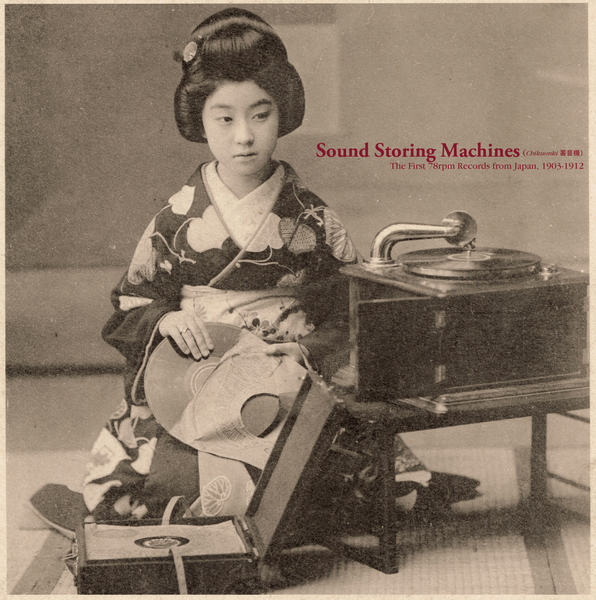"Sound Storing Machines: The First 78rpm Records from Japan, 1903-1912"
 This set all too briefly demonstrates why, from Henry Cowell to Tim Hecker, via La Monte Young, Alan Hovhaness, Olivier Messiaen, Lou Harrison, Benjamin Britten, and Ákos Nagy, many Western composers have been inspired by the sacred other-wordly elegance of gagaku music. Based on the tracks by Suenaga Togi and gagaku musicians from the Imperial Household Orchestra, a whole album by them is high on my list of coveted items. There are a variety of other styles here, with dazzling twangy sounds from the three-string samisen, Zen-meditative bamboo flute, a xylophone made of stones, boisterous songs from puppet theater, and enough surface noise to satisfy any connoisseur of hiss and crackle.
This set all too briefly demonstrates why, from Henry Cowell to Tim Hecker, via La Monte Young, Alan Hovhaness, Olivier Messiaen, Lou Harrison, Benjamin Britten, and Ákos Nagy, many Western composers have been inspired by the sacred other-wordly elegance of gagaku music. Based on the tracks by Suenaga Togi and gagaku musicians from the Imperial Household Orchestra, a whole album by them is high on my list of coveted items. There are a variety of other styles here, with dazzling twangy sounds from the three-string samisen, Zen-meditative bamboo flute, a xylophone made of stones, boisterous songs from puppet theater, and enough surface noise to satisfy any connoisseur of hiss and crackle.
Anyone familiar with Victrola Favorites will have an inkling of what to expect from this set of ultra-rare early 20th century recordings from Japan, collected by Robert Mills: 78 rpm-related exotica in the form of intriguing photographs, a variety of sounds, with good information concerning the instruments, plus cultural and historical context. Sound Storing Machines is nowhere near as lavishly packaged as Victrola Favorites (few releases are) but it comes with enough generous and intriguing information to distract from the listening process. This is not a criticism, but I decided to approach it with several full listens without reading any background, without concern for like or dislike, and merely with openness, and the spirit of “disinterestedness.” John Cage has suggested that for the making of music to have the possibility for complete and fulfilled moments one should make music “as the Orient would say” for the love of making it, as opposed to the pursuit of fame or wealth. Listeners and musicians alike should approach music disinterestedly, in order to integrate the personality - which is "why we love the art." Without much thought I first listened at low volume on tiny inbuilt laptop speakers. I began to think that this music is the perfect pitch for earbuds,which I don't possess, and only later I tried using good quality headphones at even lower volume. I will never play this album loudly through speakers.
 
Most of the recordings were done by Fred Gaisberg of the Gramophone Company and he apparently had mixed feelings:
"28 February, 1903, Tokyo: We made records of the Imperial Household Band. The orchestra was composed of 12 men and their music was weird & fascinating indeed. Though they played some 10 pieces it was impossible to distinguish one tune from another."
As aforementioned, I want a complete album by the Imperial Household Band, based on their tracks "Bairo" and "Taishikichou," which I found to be stunning flashes of a deeply beautiful ancient ceremonial music. A different style but almost as dazzling is "Senryou Nobori" which features an unknown vocalist accompanied quite brilliantly by Toyosawa Heikichi on a three stringed banjo-like instrument (samisen). This is played in the demanding Gidayu style, developed for use with puppet theater. Since Senryou Nobori was a sumo wrestler it is easy to imagine the puppet action. Later in the album, more melodramatic songs about men and families destroyed by deceit, by over-devotion to monkeys and so on seem a little preposterous, but provide contrast and have aged well for being more than a century old. The recording technology available to Gaisberg meant that the musicians had only short time to complete their work. So short that I find it hard to believe the song "Sanjusangen-do Kiyori" could possibly explore the architecture of the Sanjusangen-do Buddhist temple (from 1164 AD) featuring a hall with 1001 almost life-size statues of the Japanese bodhisattva of compassion.
There is "Collecting Water" featuring Mimasuya Kachiguri, with an unknown samisen player, on the sekkin - a kind of a xylophone made of stones used to imitate the sound of water. And there is also the shakuhachi - a bamboo flute associated with the blowing meditation of Fuke Zen monks known as "priests of nothingness." In medieval times, the ruling Shogun granted the monks an exemption to travel bans due to their wandering spiritual practice, along exclusive rights to play the instrument. This in exchange for some of them spying for the shogunate. Shogun spies also easily infiltrated the Fuke, who wore wicker baskets over their heads to symbolize their retreat from the world. In response extremely difficult shakuhachi tunes were developed as a way to root out, and sometimes kill, impostors.
The performers here probably had no idea what would happen to their recorded sounds. Some (if not all) of them would surely never have heard the result. It would be several decades until the invention of the small portable Presso Shellac Lathe and microphone used by John and Alan Lomax in many of their field recordings. Lomax could almost immediately play the recording back to the artist. Fred Gaisberg, on the other hand, would record without electricity into a large horn device, transfer to master wax cylinder, and ship these to Europe for duplicate pressings which would then have to be imported back to Japan and distributed elsewhere. He was only able to do so since the reign of the Meiji emperor 1868-1912 started Japan’s move to national modernization and openness to mechanization and globalism.
Just as ripples move concentrically outward from a stone dropped into a pool, sound travels far beyond its original point of creation. Several of these pieces are early 20th Century versions of tunes which are several hundreds of years old. And of course, in the late 1960s, the shakuhachi recording by Gorō Yamaguchi A Bell Ringing in the Empty Sky featured a piece NASA would later chose as part of the Golden Record placed aboard the Voyager spacecraft. From wicker baskets to space helmets.
 



